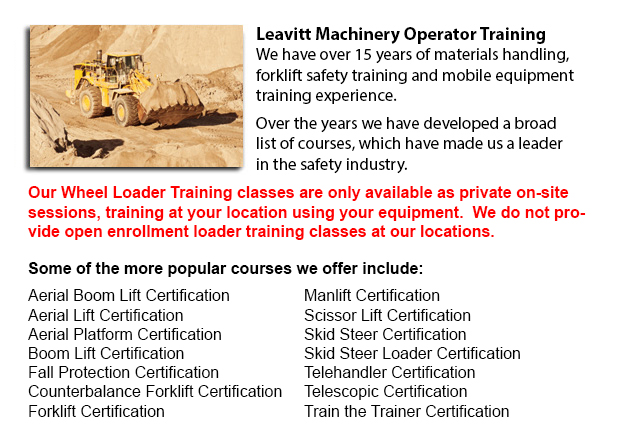
Wheel Loader Operator Training Markham - To be able to pick up considerable cargo, industrial cranes use pulleys and levers. Before, Romans used cranes to erect large monuments making the origin of these equipment at least 2,000 years ago. Many Medieval churches used cranes in their structure as well as the Egyptians may have used them when building the pyramids.
Modern cranes can either be simple or complex, based on the nature of the application they can carry out. For example, mobile cranes are somewhat simple units. A telescopic boom and even a steel truss mounts its movable platform. A system of pulleys or levers lifts the boom and there is often a hook hanging. These cranes are normally used for demolition or earthmoving by changing the hook out with another piece of gadget such as a bucket or wrecking ball. Telescopic cranes have a series of hydraulic tubes that fit together to form the boom. These units could also be mobile.
Both traditional or specialized wheels could be intended for railroad track or caterpillar track enabling these boom trucks to move on upaved and uneven surfaces.
Rough terrain and truck mounted cranes are also mobile with outriggers situated on the truck mounted model increase stability. On the other hand, rough terrain cranes include a base that tends to resemble the bottom of a 4-wheel drive. These cranes are outfitted in order to work on uneven surface making them perfect in the construction trade for example.
Gantry cranes are utilized to be able to move and unload big containers off of ships and trains. They are usually found operating in ports and railroads. Their bases have massive crossbeams that run on rails so as to raise containers from one spot to another. A portainer is a unique kind of gantry which transports supplies onto and off of ships specifically.
Floating cranes are mounted on barges or pontoons and are one more essential piece of machinery important to the shipping business. In view of the fact that they are located in water, they are used for various services comprising salvaging ships, port construction and building bridges. Floating cranes are capable of handling extremely heavy cargo and containers and similar to portainers, they can also unload ships.
Loader cranes include hydraulic driven booms which are fitted onto trailers to be able to load stuff onto a trailer. The jointed parts of the boom could be folded down if the machine is not in use. This type of crane can be even considered telescopic for the reason that one part of the boom can telescope for more versatility.
Often utilized in automated warehouses, stacker cranes tend to follow an automated retrieval system and could work by remote. These cranes are outfitted with a forklift equipment and can be seen in large automated freezers, stacking or obtaining foodstuff. Using this kind of system allows staff to remain out of that freezing setting.
Tower cranes, normally the tallest kind, usually do not have a movable base. They must be assembled piece by piece. Their base is similar to a long ladder along with the boom at right angles to the base. These cranes specialize in the construction of tall structures and are usually affixed to the inside of the building itself during the construction period.
-
Crane / Overhead Crane / Self-Erect Crane / Truck Mounted Crane / Hydraulic Cranes Training in Markham
Bridge cranes or overhead cranes are a kind of industrial material handling crane making use of a hook and line apparatus that runs on a horizontal beam running along two widely separated rails. Many overhead cranes could be seen inside a long factor... More -
Manlift Ticket Markham
Manlift Ticket Markham - The Manlifts and Elevated Platforms program provides training on the regulations, rules and correct application of safe operating procedures and work practices involved in everyday activities for individuals who work with thi... More -
Aerial Lift Train the Trainer Markham
Aerial Lift Train the Trainer Markham - The Aerial Lifts Train the Trainer Certification Program will teach trainers how to effectively train operators in safe industrial mobile equipment operation. Trainers are given in-depth instruction on aerial l... More -
Loader Operator Training Markham
Loader Operator Training Markham - Loader Operator Training - Within North America, lift truck operator training is required to be able to prevent workplace injuries and accidents. Certain forklift training would be provided to be able to offer forkl... More -
Aerial Boom Lift Ticket Markham
Aerial Boom Lift Ticket Markham - Aerial lift trucks can be used to accomplish many unique duties done in hard to reach aerial spaces. A few of the duties associated with this style of jack include performing daily repair on buildings with high ceili... More -
Boom Lift Operator Training Markham
Boom Lift Operator Training Markham - The cherry picker work platform is a type of work platform, that will usually have a bucket or platform at the hydraulic lifting system's end. The machine is likewise called a boom lift, man lift, hydraladder or... More -
Boom Lift License Markham
Boom Lift License Markham - Just fully qualified individuals must operate an aerial boom lift. Qualification can be obtained through a combination of classroom sessions and practical training with the particular kind of aerial lift that will be used... More -
Telehandler Training Courses Markham
Telehandler Training Courses Markham - The employer has the responsibility to make certain that their workers are trained to work proficiently with telehandler machines. The staff have to be assessed for their skill to utilize the equipment. If defic... More

Forklift Training Markham
TOLL FREE: 1-888-254-6157
Markham, Ontario
forklifttrainingmarkham.com
Email Us
About Us


